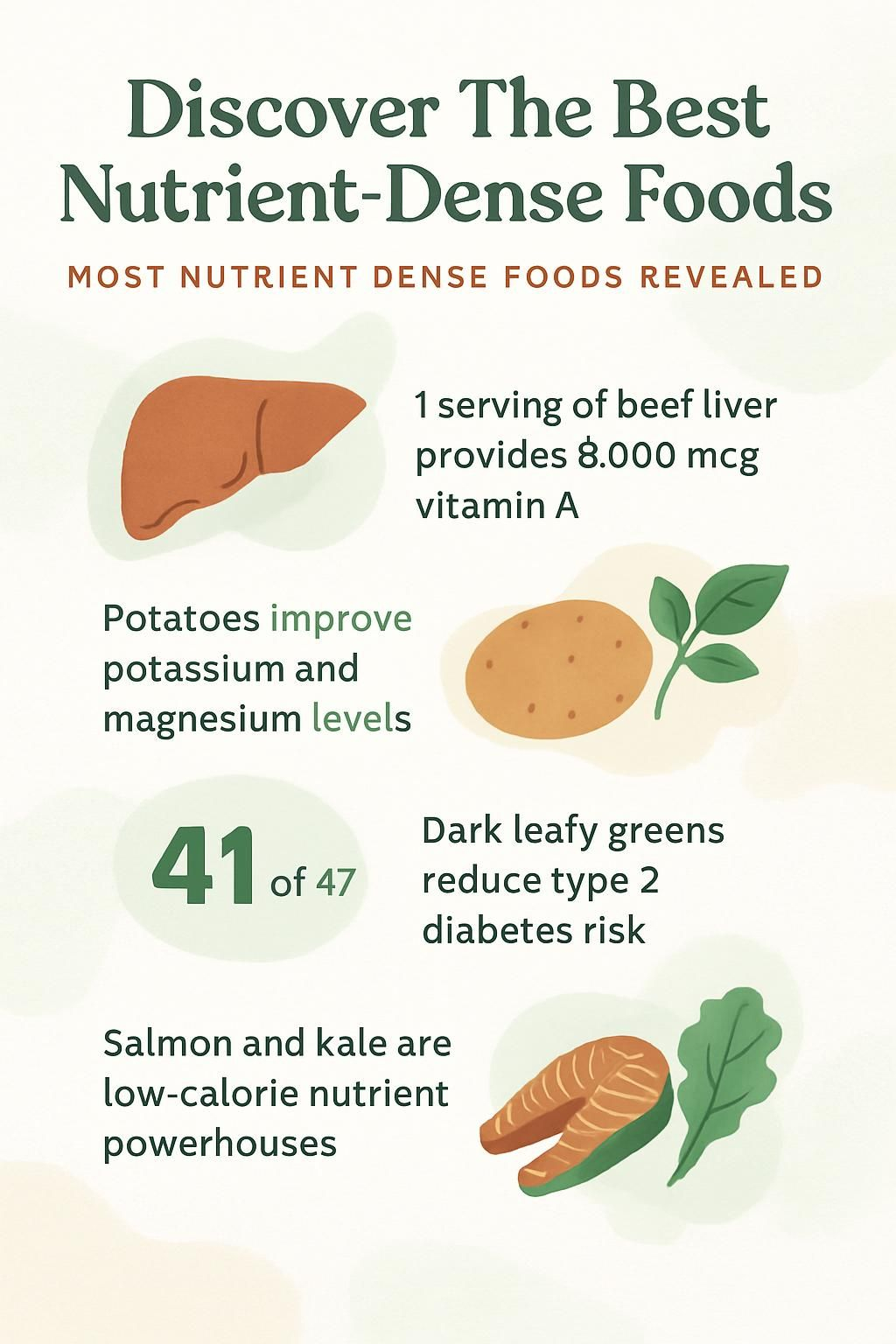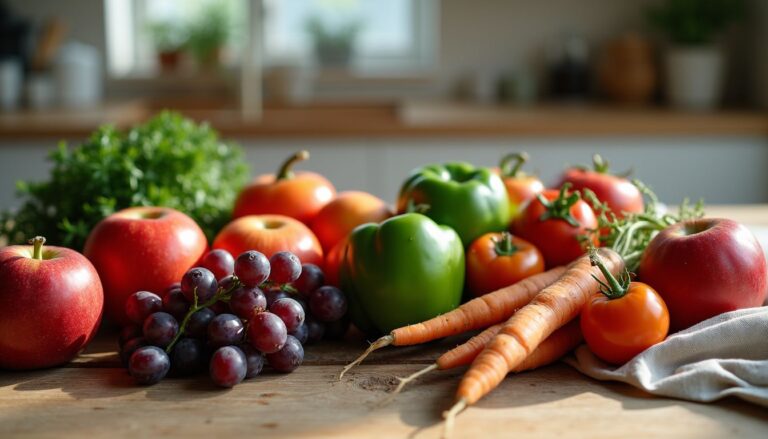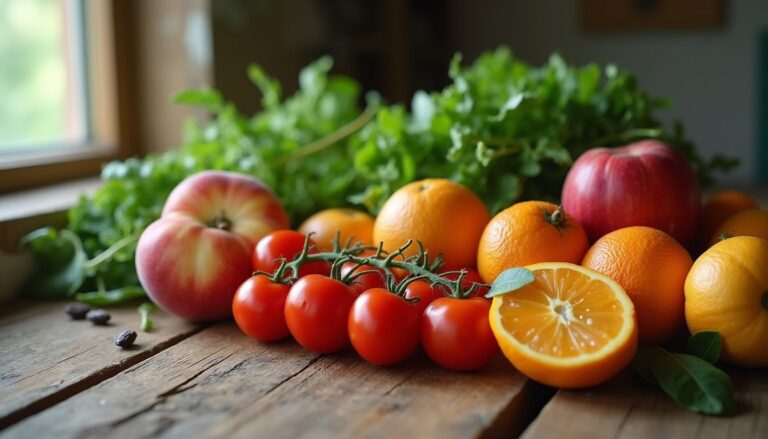Discover The Best Nutrient-Dense Foods: Most Nutrient Dense Foods Revealed
Our Nutrition Assistant AI Suite will transform your body. You will lose fat, get toned, and build muscle. Gain confidence and optimal health.
You want food that works hard for your health, not just your hunger. A nutrient-dense food packs many vitamins and minerals into each calorie, with little added sugar or unhealthy fat. Choosing these healthy foods helps you meet daily needs for protein, fiber, calcium, potassium, and more without extra calories.
This guide shows you which fruits and vegetables, lean proteins, leafy greens like kale and spinach, nuts, fatty fish such as salmon or sardines, eggs, and whole grains deliver the most nutritional value. You will see how these choices support energy, immunity, and long-term health. Keep reading to explore the most nutrient dense picks and how to use them every day.
Key Takeaways
- Nutrient-dense options such as salmon, kale, shellfish, eggs, and potatoes offer many vitamins, minerals, and protein for relatively few calories.
- Powerhouse fruits and vegetables, called PFVs, score above 10 per 100 calories on a nutrient density scale. In a CDC analysis, 41 of 47 tested items met that mark.
- Eating organ meats like beef liver once a week can provide more than 8,000 mcg RAE vitamin A and over 250 mcg DFE folate per 100 grams.
- Regular intake of dark leafy greens, beans, nuts, and fatty fish supports heart health and may reduce risks for chronic disease, including type 2 diabetes.
- Analyses of U.S. NHANES data from 2001 to 2018 link potatoes in adolescent diets with better potassium and magnesium status.

What Are Nutrient-Dense Foods and Why Do They Matter?

Nutrient-dense foods give you a high amount of vitamins, minerals, and other helpful nutrients per calorie. Choosing these healthy foods supports your nutrition goals and can improve your health at every meal.
What Defines Nutrient-Dense Foods?
Nutrient density means more nutrients for fewer calories. You get more value from each bite, which helps you meet daily needs without overeating.
Foods like fatty fish, dark leafy greens, and cruciferous vegetables such as kale and spinach provide iron, magnesium, vitamin K, folate, and omega-3 fatty acids per calorie. Researchers use a nutrient density score to compare foods. Powerhouse fruits and vegetables, or PFVs, score above 10 per 100 calories, and most in that group support heart health and help protect against chronic disease.
These choices offer broad nutrient profiles with good bioavailability, which means your body can absorb the nutrients well.
What Are the Key Features of Nutrient-Dense Foods?
Nutrient-dense foods supply many micronutrients compared to their calorie load. You often get vitamins A, C, K, B6, B12, and folate, plus minerals like calcium, iron, zinc, and magnesium.
Top picks, including organ meats and green leafy vegetables, can deliver more than 10 percent of your Daily Value for many essential nutrients in just 100 kcal. You also gain dietary fiber and healthy fats, such as omega-3s from seafood and eggs. Plant foods add antioxidants such as lutein and beta-carotene that help calm inflammation.
Whole or minimally processed foods keep nutrient quality high and limit empty calories. Bioavailability matters. For instance, your body absorbs more iron from ruminant meat than from plants. Foods with very high nutrient density include oysters and other bivalves, eggs rich in B vitamins and selenium, potatoes with vitamin C and fiber, nuts for vitamin E and magnesium, and legumes for plant protein. The American Heart Association encourages variety across food groups for complete nutrition and heart health.
How Does a Nutrient-Rich Diet Improve Your Health?
A nutrient-rich eating pattern supports your core systems, from digestion to immunity. Balanced meals with nutritious foods are linked to better energy, bone strength, and long-term wellness.
How Do Nutrient-Dense Foods Boost Overall Health?
Dark green leafy vegetables, shellfish, organ meats, and small fish provide steady amounts of vitamins and minerals that protect cells from damage. Diets rich in these foods may reduce the risk of cancer and other chronic diseases.
Studies show certain foods can help lower blood pressure and cholesterol, such as dark chocolate with 70 to 85 percent cocoa. Shellfish like clams and oysters bring vitamin B12 and zinc that support immune function. In India, adding potatoes to school meals improved micronutrient adequacy in adolescents in a 2021 study. Nutrient-rich diets also support bones, skin, digestion, and weight control by pairing fiber with essential nutrients at a reasonable calorie level.
Can Nutrient-Dense Foods Increase Energy Levels?
Potatoes provide potassium, magnesium, iron, manganese, vitamin C, and B vitamins. These nutrients help your metabolism turn food into energy. In U.S. data from 2021, adolescents who ate potatoes showed higher levels of these essential nutrients.
Dark leafy greens such as kale and spinach are low in calories yet rich in nutrients for energy production. Eggs supply high-quality protein and healthy fat, which helps keep energy steady. Small dried fish offer easy-to-absorb iron and B vitamins, which can support energy needs for women and children. Cheese adds concentrated calcium and protein, which is useful for growth in kids and during pregnancy.
How Do Nutrient-Dense Foods Help With Weight Management?
Dark leafy greens and low-fat yogurt help with weight control because they pack nutrients into few calories. One cup of raw kale has about 33 calories and provides vitamin C, vitamin K, and calcium.
High-fiber choices keep you full longer. Potatoes with skins increase satiety more than rice or pasta, as shown in research. Eggs at breakfast can support fullness and weight loss efforts. Foods like spinach, watercress, berries, oats, beans, and nuts offer many nutrients per bite while helping manage hunger. Building meals from minimally processed foods helps prevent overeating and supports a healthy weight.
What Role Do Nutrient-Dense Foods Play in Strengthening Immunity?
Many of the same foods that help with weight also support your immune system. Vitamin C rich picks like kale, broccoli, and berries help your body fight infection. Garlic contains allicin, a compound linked to healthier blood pressure and cholesterol, which supports heart health too.
Clams and oysters provide zinc and vitamin C, two nutrients tied to strong immune defense. Liver supplies vitamin A, which supports white blood cells. Seaweed gives iodine, a mineral your thyroid uses to guide immune response. Eggs add choline and other minerals that aid immune function. A simple plan, such as pairing eggs, spinach, berries, and salmon during peak cold season, may help you feel more resilient. Bitter melon brings plant antioxidants that are being studied for blood sugar control and general immune support.
Top Nutrient-Dense Foods to Add to Your Diet
Think of this as your short list of reliable building blocks for a healthy plate.
What Are the Benefits of Eating Fatty Fish?
Fatty fish like salmon and sardines are rich in omega-3 fatty acids, which can reduce the risk of heart disease and stroke. A 100 gram serving of wild Atlantic salmon provides about 2.2 grams of omega-3s and 25.4 grams of protein for muscle growth and repair.
Fatty fish add magnesium, potassium, selenium, and B vitamins that support energy metabolism. They also supply vitamin D, which supports bone health and immune function. Sardines are low in mercury compared with many other seafood choices, which makes them easier to eat more often. Choose sustainable sources when possible to support both your health and the environment.
Why Is Salmon Considered Nutrient-Rich?
Salmon stands out for omega-3s and high-quality protein. One 100 gram serving of wild Atlantic salmon provides about 2.2 grams of omega-3s and 25.4 grams of protein.
Salmon also provides magnesium, potassium, and selenium, which support your heart and immune system. B vitamins, including B6, support energy production. Salmon is usually lower in mercury than larger fish like swordfish. Whether farmed or wild-caught responsibly, salmon brings flavor and a strong nutrient profile to your plate.
What Nutrients Do Sardines Provide?
Sardines offer protein for muscle repair and omega-3s for heart health. They are also lower in mercury than many other types of seafood, which makes them a safe regular choice.
When you eat them with the bones, you get a quality source of calcium for bones and teeth. Sardines provide vitamin D and B12, which support bone strength and nerve function. Selenium in sardines acts as an antioxidant that helps protect cells. Try sardines on salads or in tomato sauce with whole grain pasta for an easy, nutrient-dense meal. They are also one of the more sustainable seafood options.
What Are the Health Benefits of Dark Leafy Greens?
Kale, spinach, and collard greens are among the most nutrient-dense vegetables. One cup of raw kale has about 33 calories and includes vitamins A, C, K, and B6, plus calcium, iron, potassium, and magnesium.
Vitamin A and the carotenoids lutein and zeaxanthin support eye health. Folate helps with cell growth. Fiber improves digestion and satiety. Antioxidants in these greens may lower cancer risk. Replacing refined snacks with salads made from leafy greens can increase energy and reduce cravings.
Why Is Kale Nutritionally Valuable?
Kale brings vitamins A, C, K, and B6, along with potassium, calcium, iron, and fiber. These nutrients support immune function, bone health, and digestion while keeping calories low. Kale also supplies antioxidants that protect your cells.
In the PFV ranking, kale scores 49.07 on nutrient density. You can enjoy it raw in salads, sautéed, or blended into smoothies. Adding kale helps boost fiber intake and key minerals that support heart health.
What Makes Spinach a Superfood?
Spinach ranks second on the PFV list with a nutrient density score of 86.43. It delivers vitamins A, C, and K, plus folate and iron, at a very low calorie cost.
Spinach also provides potassium and magnesium for heart health. Vitamin K supports strong bones. Mild in flavor and easy to add to eggs, soups, and salads, spinach upgrades meals without changing taste much.
Why Should You Include Collard Greens?
Collard greens provide vitamins A, C, and K, along with calcium and potassium. The fiber supports digestion and fullness while calories stay low.
As a PFV, collards offer antioxidants and phytonutrients that protect cells from damage. Steam or sauté them for a simple side, or stir chopped collards into soup for extra nutrients.
How Do Organ Meats Provide Essential Nutrients?
Liver, spleen, kidney, and heart are among the most nutrient-dense animal foods. A 100 gram serving of beef liver delivers large amounts of vitamin B12 and vitamin A, plus copper, iron, phosphorus, zinc, selenium, niacin, folate, riboflavin, vitamin B6, and protein.
These organs provide moderate to high levels of many key micronutrients needed through the life span. Health professionals often suggest including organ meats once a week for nutrient adequacy.
Why Is Liver a Nutrient Powerhouse?
Liver ranks at the top for micronutrient density. A 100 gram portion of beef liver provides about 8,645 mcg RAE vitamin A and 257 mcg DFE folate, which support vision and development.
It also supplies iron and zinc, which help prevent anemia and support immune health. B vitamins in liver aid energy production. With copper, phosphorus, selenium, and protein, liver covers many needs without relying on supplements. Eating liver weekly can help you reach your micronutrient goals more easily.
What Minerals Are Found in Kidney?
Kidney provides iron and zinc, which support immune function and energy metabolism. It also contains selenium, an antioxidant mineral, plus copper for healthy blood vessels and nerves.
Phosphorus in kidney supports strong bones and teeth. Kidney offers several B vitamins for daily energy. A 100 gram serving of cooked beef kidney supplies about 4 mg of iron and 2 mg of zinc. If you enjoy organ meats, rotating kidney with liver adds variety and important minerals.
What Nutrients Do Shellfish Offer?
Clams, oysters, scallops, and mussels are highly nutrient dense. They provide vitamin B12, zinc, iron, selenium, potassium, and vitamin C.
Clams are a top source for many of these nutrients. Bivalves deliver protein and essential trace minerals in a low-calorie package. With careful sourcing, shellfish can be a safe and sustainable choice. They are often recommended in pregnancy for micronutrient adequacy.
How Do Oysters Benefit Your Health?
Oysters deliver very high levels of vitamin B12 and zinc, which support the nervous system and immunity. They also provide vitamin C, potassium, selenium, and iron.
Oysters offer one of the best sources of easy-to-absorb iron. They support heart health with antioxidants and provide iodine for thyroid function. Oysters are rich in protein but low in calories, which makes them helpful for weight goals. With sustainable harvesting, they are also friendly to the environment.
Why Are Mussels a Great Choice?
Mussels are high in protein and low in fat. A serving provides vitamin B12, iron, and zinc to support immune health and prevent common deficiencies.
Mussels also supply vitamin A, calcium, and omega-3 fatty acids without the mercury risk linked to some larger fish. Harvested responsibly, they are a sustainable option. They pair well with garlic and lemon for a quick, nutritious meal.
How Are Eggs Versatile and Nutritious?
Eggs are a compact source of protein, healthy fats, and key vitamins and minerals. They provide selenium, riboflavin, and vitamin B12 for energy production. Choline supports brain health, and lutein with zeaxanthin supports eye health.
Eggs are easy to cook, budget friendly, and flexible. Boil, scramble, or add to soups and stir-fries to raise nutrient density at any meal. For many lacto-ovo vegetarians, eggs supply important nutrients that are harder to get from plants alone.
What Are the Health Benefits of Garlic?
Garlic earns a PFV label because it is nutrient dense for very few calories. It provides vitamin C, vitamin B6, selenium, copper, and manganese.
Allicin, a compound in crushed garlic, has been linked to lower blood pressure and cholesterol in clinical research. Garlic brings antioxidant and anti-inflammatory effects that support immune function. It adds flavor and health benefits in almost any savory dish.
Why Add Seaweed to Your Diet?
Seaweed delivers calcium, iron, magnesium, and iodine. Iodine supports your thyroid, which controls metabolism. Many types also provide vitamin A and B vitamins.
Its fiber helps gut health while calories stay very low. Enjoy seaweed in sushi, soups, or as a topping. It contains plant antioxidants that help protect cells and is a sustainable choice in many cuisines.
Are Potatoes More Than Just Carbs?
Potatoes bring potassium, magnesium, iron, copper, manganese, vitamin C, and B vitamins. Eating the skin adds fiber for better digestion and longer fullness. Analyses of NHANES data from 2001 to 2018 show that adolescents who eat potatoes have higher levels of several key minerals.
Potatoes also contain resistant starch, which supports steady energy. They provide antioxidants that help fight free radicals. Compared with rice or pasta, potatoes often offer more satiety for fewer calories. A baked potato after exercise can be a simple, satisfying recovery snack.
How Do Nuts and Seeds Provide Healthy Fats?
Nuts and seeds supply healthy fats that support heart health. Chia and flax provide omega-3 fatty acids, which can lower inflammation. Almonds add monounsaturated fats plus vitamin E and calcium.
Walnuts and sunflower seeds offer protein and fiber for fullness, along with minerals such as magnesium and zinc. These plant foods fit well in a plant-based diet and add crunch, flavor, and nutrients to yogurt, salads, and grain bowls.
What Nutrients Are in Almonds?
Almonds are a strong source of vitamin E, which supports skin and immunity. One ounce provides about 37 percent of the Daily Value for vitamin E and also adds magnesium, calcium, and potassium.
They deliver plant-based protein and heart-healthy fats for steady energy. With around 6 grams of protein per ounce and helpful fiber, almonds support digestion and reduce oxidative stress.
Why Are Chia Seeds Considered a Superfood?
Chia seeds are rich in omega-3 fats, fiber, and protein. They also provide calcium, magnesium, and phosphorus. Their antioxidants may reduce inflammation and support immune health.
Chia absorbs liquid, which makes it easy to stir into smoothies, oatmeal, or yogurt. One tablespoon provides about 4 grams of fiber and a mix of minerals, all with very few calories.
What Are the Benefits of Flaxseeds?
Flaxseeds supply omega-3 fatty acids, mainly ALA, that support heart health. They are also high in soluble and insoluble fiber, which supports digestion, fullness, and stable blood sugar.
Lignans in flax act as antioxidants and may lower the risk of certain hormone-related cancers. Regular intake is linked with lower LDL cholesterol. Add ground flax to oatmeal, smoothies, or baked goods for a quick nutrition boost.
Nutrient-Dense Vegetables and Fruits for Every Meal
Colorful produce brings a wide range of vitamins, minerals, and plant compounds to your plate.
Why Should You Eat Cruciferous Vegetables?
Broccoli, Brussels sprouts, and cauliflower provide vitamins A, C, K, folate, and fiber. Their fiber supports digestion and fullness with few calories, which helps with weight management.
These vegetables contain glucosinolates, bioactive compounds being studied for potential anti-cancer effects. Folate is especially important before and during pregnancy. Eating more cruciferous vegetables also helps maintain a diverse gut microbiome.
What Are the Health Benefits of Broccoli?
Broccoli supplies vitamins A, C, and K that support immunity, bones, and daily needs. One cup of raw broccoli provides close to a full day’s worth of vitamin C for many people.
It is a good source of dietary fiber, which supports digestion and satiety. Research on sulforaphane, an antioxidant compound in broccoli, links it with cellular protection and heart benefits as reported in the Journal of Nutrition in 2014.
What Nutrients Are in Brussels Sprouts?
Brussels sprouts are rich in vitamin C for immune support and vitamin K for bone strength. They offer fiber to support digestion and weight control, along with folate for DNA synthesis.
Low in calories and high in minerals like manganese and potassium, Brussels sprouts fit well in a nutrient-dense diet. Their antioxidants may help lower chronic disease risk. Roasting them with olive oil makes an easy side dish.
Why Is Cauliflower Low in Calories but High in Nutrients?
Cauliflower is mostly water and fiber, which keeps calories low while nutrients stay high. One cup has about 25 calories yet provides vitamin C, vitamin K, folate, potassium, and a little protein.
Swapping higher calorie sides for roasted or steamed cauliflower raises nutrient density without extra energy intake. Mashed cauliflower can stand in for mashed potatoes while still offering volume and satisfaction.
How Do Berries Provide Antioxidants?
Blueberries, strawberries, and blackberries are rich in anthocyanins and other polyphenols. These antioxidants help protect cells from free radical damage and may support brain health.
A daily serving of berries adds vitamins, minerals, and fiber with modest calories. Studies suggest berry compounds support heart function and healthy blood flow. Adding berries to yogurt or oatmeal is a simple way to raise antioxidant intake.
What Nutrients Are in Blueberries?
Blueberries provide anthocyanins that give them their deep color and protect cells. They also supply vitamin C for immune health and fiber for digestion and fullness.
Potassium in blueberries can support healthy blood pressure. Some research links blueberries with better memory and cognitive function. They fit easily into breakfasts and snacks.
Why Are Strawberries Sweet and Nutritious?
Strawberries taste sweet due to natural sugars like fructose and glucose, yet they remain low in calories. They provide vitamin C and anthocyanins that protect cells and support healthy skin.
The fiber in strawberries helps digestion and may support stable blood sugar. They add key minerals and a fresh taste to salads, yogurt bowls, and snacks.
How Can You Include Nutrient-Dense Foods in Your Meals?
Small changes stack up fast. A few smart swaps can upgrade every plate you build.
How Do You Create Balanced Meals With Nutrient-Dense Foods?
Build meals with three parts: a protein source, colorful produce, and a smart carb. For protein, choose eggs, organ meats, or small fatty fish like sardines and salmon. For produce, add dark leafy greens such as kale and spinach, then mix in cruciferous vegetables or berries.
For smart carbs, pick whole grains or starchy vegetables like potatoes. Add nuts or seeds, such as almonds and chia, for healthy fats that help you absorb fat-soluble vitamins. Favor steaming or sautéing instead of boiling to keep more vitamins. Buying local, seasonal produce can improve quality and reduce cost.
What Are Some Nutrient-Rich Snack Options?
- Small dried fish for calcium, iron, and vitamin A.
- Plain yogurt with chia seeds and almonds for protein, probiotics, and healthy fats.
- Kale chips or crunchy carrot sticks for fiber, vitamin A, and vitamin K.
- Hard-boiled eggs for protein, vitamin B12, and selenium.
- Chilled oysters or clams where available for zinc and vitamin B12.
Simple combinations, such as Greek yogurt with berries or nuts, give you steady energy and strong nutrient density with little prep.
How Can You Add Variety With Nutrient-Dense Ingredients?
Rotate ingredients each week to cover more nutrients. Cycle between leafy greens, fatty fish, organ meats, and different nuts and seeds. Use new cooking methods to change the flavor, such as roasting kale or grilling salmon.
Borrow ideas from global cuisines. Use seaweed in miso soup or try Mediterranean bowls with chickpeas, olive oil, and sardines. Build grain bowls with roasted vegetables, mussels, chia seeds, and avocado for a complete meal.
Conclusion
Choosing nutrient-dense foods helps you meet daily needs for vitamins, minerals, fiber, and healthy fats. Salmon, berries, kale, shellfish, eggs, almonds, and potatoes are reliable building blocks for energy, heart health, and immune support.
Mix fruits and vegetables with lean proteins and smart carbs to cover your bases without added sugar or empty calories. Aim for variety across the week. If you have a medical condition, talk with a registered dietitian or your clinician for personalized advice. This article is for general education only.
FAQs
1. What are the most nutrient-dense foods, and why do they matter for health?
Nutrient-dense foods provide high amounts of vitamins and minerals per calorie. Leafy greens like spinach, nuts such as almonds or walnuts, and seafood including sardines offer rich sources of essential nutrients. For example, spinach contains iron and magnesium; nuts supply healthy fats along with vitamin E; sardines deliver protein plus calcium. Eating these foods supports strong bones, muscle function, and overall well-being according to research from the Harvard T.H. Chan School of Public Health.
2. How do mineral-rich foods support a balanced diet?
Mineral-rich foods help maintain nerve signals, fluid balance, and bone strength in the body. Foods like seeds (pumpkin or sunflower), dairy products (milk or yogurt), fish (salmon), and certain fruits contain key minerals such as potassium, calcium, zinc, and magnesium. Including a variety of these options ensures you meet daily requirements for optimal health.
3. Are all nuts considered nutrient-dense fruits?
Not all nuts have equal nutritional value but many qualify as nutrient-dense fruit due to their concentration of fiber, protein, healthy fats, vitamins B6 and E plus important minerals like selenium or copper. Almonds stand out for vitamin E content while Brazil nuts are notable for selenium levels based on USDA data tables.
4. Should I worry about mercury when choosing seafood as a nutrient source?
Some types of fish can contain higher levels of mercury which is an element that may harm health if consumed in large amounts over time especially by children or pregnant women according to FDA guidelines. Choosing smaller fish such as sardines or anchovies helps limit mercury exposure while still providing valuable nutrients like omega-3 fatty acids.
Summary: Nutrient-dense choices include leafy vegetables packed with minerals; nut varieties offering beneficial fats; mineral-rich animal products; and low-mercury seafood options that promote good nutrition without excess risk from elements like mercury.







